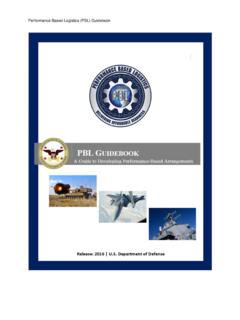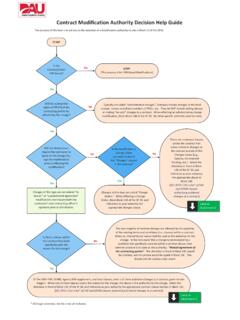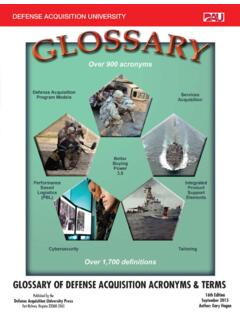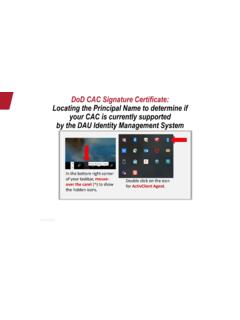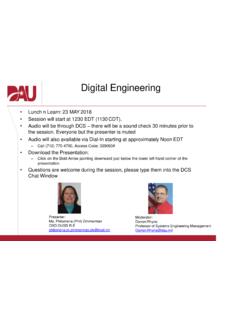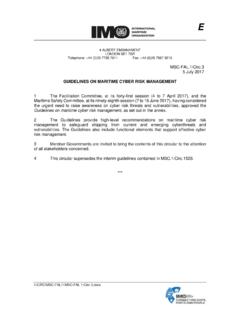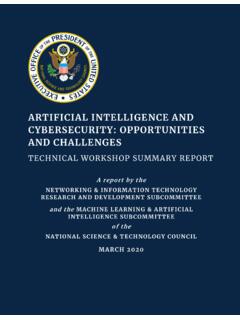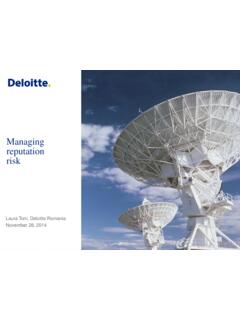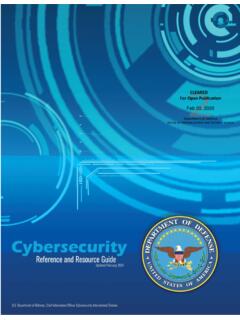Transcription of Supply Chain Risk Management - DAU
1 Supply Chain Risk Management An Introduction to the Credible Threat Heath Ferry n Van Poindexter Defense AT&L: July-August 2016 18. W. SPECIAL SECTION: RISK Management . e live in a wonderful world of instant information, and everything is connected. All we have to do is pull out our phones, tablets, laptops or any other similar device and get the information we need virtually instantaneously. While all this advanced communications technology constitutes one of the greatest things about living in a technologically advanced world, it also exposes us to one of the biggest threats. How can we be sure that any and all of these devices were made to strict manufac . turing standards and weren't designed with the flaws built in or downloaded? Some of the same tools that make our lives easier also could leave us wide open to a cybersecurity breach. This article examines the elements of Supply Chain risk Management , the national security risks associated with exploitation, and the concerns for the Department of Defense (DoD).
2 According to the November 2012 DoD Instruction (DoDI) , Supply Chain Risk Management (SCRM) is a systematic process for managing Supply Chain risk by identifying susceptibilities, vulnerabilities and threats throughout DoD's Supply Chain and developing mitigation strategies to combat those threats whether presented by the supplier, the product and its subcomponents or the Supply Chain ( , initial production, packaging, handling, storage, transport, mission operation and disposal). So what does all of this mean to the government and the overall acquisition life cycle? SCRM. is a credible inside threat every bit as much as a malicious insider, counterfeiters, terrorists or industrial espionage agents. Is SCRM just a cyber issue? An intelligence issue? An acquisition issue? Honestly, it is all the same and should be treated as such. A concerted effort should be made, across all levels and domains, to address it at every step of the acquisition life cycle.
3 The DoD, military, business and intelligence operations including communications and command and control rely heavily on trusted networked systems, devices and platforms. All of these components support the ever-increasing number of capabilities that support the DoD's missions. Every component is designed, manufactured, packaged and delivered to end users, and global Supply chains provide multiple attack vectors that increase a program's cybersecurity risk. The Supply Chain is a globally distributed and interconnected web of people, processes, technology, information and resources that creates and delivers a product or service. Global Supply chains are dynamic, multilayered and complex. Lack of visibility and traceability through all of the diverse layers of the Supply Chain create security challenges because each component has its own Supply Chain that provides multiple opportunities for an adversary to sabotage the raw materials, manufacturing processes, packaging and even shipping.
4 All of these can collect information on DoD systems and lead to either industrial or traditional espionage. Ferry is one of the newest cybersecurity professors at the Defense Acquisition University (DAU) South Region in Huntsville, Alabama. He currently provides Mission Assistance, curriculum development, and support to all segments of the Defense Acquisition Workforce. He holds a master's degree in cybersecurity and has multiple cybersecurity certifications. Poindexter is a professor at DAU South Region. He currently is involved in enhancing the awareness and proactive involvement of support managers and logisticians in identifying and mitigating risks in the Department of Defense Supply Chain . He is working on his doctorate in education. 19 Defense AT&L: July-August 2016. The Need to Manage the Supply Chain Figure 1. The Four Aspects of Supply Everything is interconnected today, and one component in Chain Risk Management a system or network can have an impact on one system or on multiple systems at the same time.
5 Therefore, risk must Security provides the confidentiality, integrity and be considered for each component before it is purchased or availability of information. integrated into a system. The more critical the mission, the Integrity focuses on ensuring that the products or system and the component, the more diligent we must be in services in the Supply Chain are genuine and contain managing risk. Risk Management decisions require that the no unwanted functionality. decision maker consider three factors (cost, schedule and Resilience focuses on ensuring that the Supply Chain performance) and consider the impact of his or her decision provides required products and services under stress. about the desired or needed level of performance (in this case, Quality focuses on reducing unintentional vulnerabili cybersecurity ) in the context of the impact of performance ties that may provide opportunities for exploitation. criteria on cost and schedule.
6 A May 2012, Senate Armed Services Committee inquiry re . port stated that China was found to be the dominant source country for counterfeit electronic parts, a major vulnerability in the Supply Chain . The Chinese government has failed to take steps to stop counterfeiting operations, which means DoD. must step up its efforts to manage and mitigate the counter . feit threat. Unfortunately, DoD lacks knowledge of the sheer scope and impact of counterfeit parts on critical defense sys . tems. This lack of knowledge can compromise performance, reliability of defense systems and can even risk the safety of military personnel. The defense industry's reliance on unvetted independent distributors and the weaknesses in their testing regime for electronic parts creates unacceptable risks and vulnerabilities. The defense industry routinely failed to report cases of suspect counterfeit parts. This has to stop. Source: National Institute of Standards and Technology (NIST) SCRM traditionally refers to managing risks in the manufac.
7 Special Publication 800-161, Supply Chain Risk Management Prac- turing and delivery Supply chains. Globalization requires that tices for Federal Information Systems and Organizations, April 2015, SCRM include the process of identifying critical components Page 4. and functions; identifying Supply Chain threats, vulnerabilities, and risks ; determining likelihood (susceptibility) and the im . pact of those risks ; and developing strategies in response. All of these Supply Chain exploitation risks should be assessed at each stage of the life cycle. Supply Chain risk, by definition, is any risk that an adversary may use in order to sabotage, exfiltrate information, mali How to Manage It ciously introduce unwanted function or otherwise subvert One solution might be to buy only products, but the design, integrity, manufacturing, production, distribution, this usually is difficult and could carry a higher cost, with the installation, operation or maintenance of a system so as to exception of certain very critical components.
8 Trusted Suppli . surveil, deny, disrupt or otherwise degrade the function, use, ers (including Trusted Foundries) have been accredited by the or operation of that system. Other risks include the insertion Defense Microelectronics Activity to provide secure design, of counterfeits, unauthorized production, tampering, insertion manufacturing, packaging and testing services. These suppli . of malicious software, loss of confidential government infor ers also provide foundry capability, prototyping, testing and mation, and poor manufacturing and development practices packaging services. Producing chips or other microelectron . in the Supply Chain . Counterfeit components have the poten ics through a Trusted Supplier can be more expensive than tial to degrade performance, but they often are introduced purchasing chips from commercial sources. into the Supply Chain for financial rather than malicious pur . poses. Counterfeits can contain intentional modifications for The Trusted Foundry program was started in 2004 to ensure the purpose of sabotage or exfiltration of information.
9 SCRM that mission-critical national defense systems had access to focuses more on identifying the potential impacts of threats microelectronics from secure, domestic sources. This pro . from malicious actors, rather than counterfeits. Supply Chain gram identifies Trusted Foundries for contract semiconduc . weaknesses and vulnerabilities offer adversaries attack vec tor manufacturing at features sizes down to 22 nanometers. tors for cyber exploitation and manipulation. Although most SCRM focuses on the tactical end protecting Defense AT&L: July-August 2016 20. There is growing concern that counterfeit each critical component begins with determining its source parts generally the misrepresentation of and possible attack vectors along the Supply Chain . a part's identity or pedigree can seriously Responses to Risk disrupt the DoD Supply Chain , harm It is impossible to eliminate all risks associated with the sup . weapon systems integrity, and endanger ply Chain , especially when it comes to the use of electronics, computers and other computerized components.
10 The attempt troops' lives. Additionally, with many to remove or mitigate risks can be extremely expensive and manufacturing steps being performed off- time consuming. Applying countermeasures and mitigations shore, sophisticated adversaries have the will lessen the consequence of a compromised component or system by incorporating risk Management strategies through . opportunity to inject vulnerabilities that out a component's or system's life cycle. There are four basic introduce kill switches, back doors or Trojan ways to address identified risk: viruses to render systems ineffective upon Treat it: Employ protective measures (countermeasures and command or to leak sensitive information. mitigations) that may either reduce the consequence or like . Source: Trusted State-of-the-Art Microelectronics Strategy lihood of a threat exploiting or triggering a vulnerability, or remove the threat or vulnerability that generates the risk. Study, July 2015, Potomac Institute for Policy Studies Transfer it: Allocate some or all of the responsibility for risk report.
